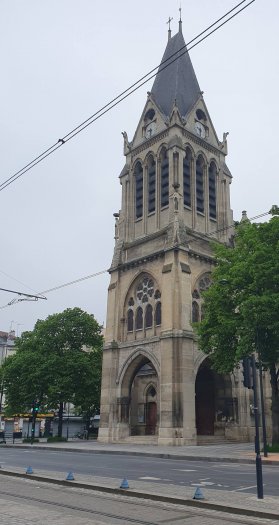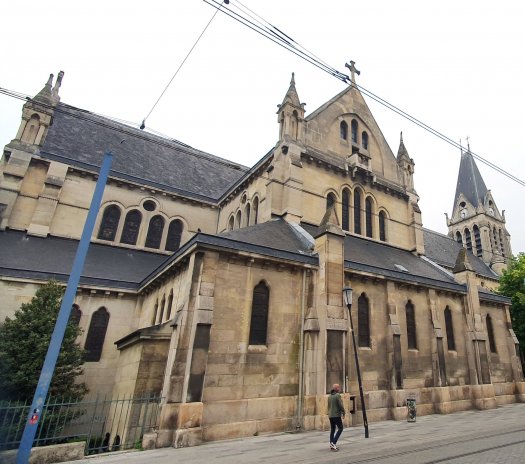

Archaeological excavations carried out in Saint Denis revealed the existence of a village in that particular place from the Merovingian era. Built on a Gallo-romaine road, the Via-Strata, from which the Church gets its name, the Church de L’Estrée was situated outside the fortification walls which surrounded the village. These fortification walls were ordered by Charles-Le-Chauve to protect the Viking location. This primitive church had already been dedicated to Saint Denis. The present day church Saint Denis de L’Estrée, built in the nineteenth century, is usually called “Eglise Neuve” by the Dionysian population. Its construction took place at the same time as the restoration of the Basilica Cathedral and it was under the responsibility of the prestigious architect Viollet-le-Duc.
When, in the nineteenth century, the Basilica Cathedral in Saint Denis was ranked as one of the monuments to be restored, the task was given to the architect Debret. But mistakes committed by him obliged him to stand down and Violet Le Duc was entrusted with the restoration of the Basilica Cathedral. Born into a French family of the great bourgeoisie, Eugene Emmanuel Viollet- Le-Duc (1814-1879) was a self-taught man. He refused to attend the School of fine arts and trained himself on architectural art by travelling through France and Italy. During his career, he wrote his own notes and made his own sketches, not only on the buildings he restored, but also on all Roman, Gothic and Renaissance construction destined to be demolished. His studies were not just limited to architectural Works, Viollet-Le-Duc was also interested in furniture, clothes, musical instruments, and weaponry…
Mérimée, was at that time, General Inspector of classified listed monuments, and he introduced Viollet-Le-Duc to the Imperial court of Napoleon the third who entrusted him with the renovation of the castle of Pierrefonds. This was the beginning of an atypical career. Although having constructed little, Viollet-Le-Duc dominated French architecture from 1840 to 1870. The many medieval monuments he undertook, as famous as the cathedral of Amiens (1849), Notre Dame de Paris (1844), the Basilica Cathedral of Saint Denis (1846) or even the fortifications of Carcassonne (1844), earned him a solid reputation. However, it was not his numerous works that made him famous but the criticisms which they generated. The first contestation came from Anatole Leroy-Beaulieu, in 1874, concerning the restoration of the cathedral of Evreux which had been judged as cumbersome. Various architects and archaeologists shared this point of view. At the end of the nineteenth century, all Europe critised his restoration practice and even the name of the architect became synonym with bad taste: the common saying then! Done like Viollet-le-Duc!
However, when, after the First World War, major medieval monuments had to be restored, his major theoretical lectures on Gothic structure and his conception of restoration were called upon. It is indeed one of the valuable lessons that architects from the twentieth century learned from Viollet-Le-Duc’s works through, notably his own definition : “restoring a building, is not to maintain […], it is to restore it back into a complete state that may never have existed at a given point in time”.
His different work projects gave another way to perceive the authenticity of an old monument (respecting stone size for example), but also a renaissance of decorative arts.
Viollet-le-Duc was also a historian and in particular a theorist on architecture. His ideas inspired many of his contemporaries such as creators of Art Nouveau at the turn of the twentieth century. Historical production by Viollet-le-Duc was closely linked to that of restorer since he carried out many surveys on sites, work on existing buildings, drawings and ink wash. When at his time, most historians were satisfied with written text, the originality of Viollet-le-Duc consisted in including in historical commentaries descriptions on construction and objects, participating thus in the development of a history of civilizations.
Even as restoration works on the Basilica were being carried out fully under the direction of Viollet-le-Duc, he continued to draw up plans for the new church “église de L’Estrée”. The façade of Saint Denis de L’Estrée, oriented towards the East, stood facing squarely to the Basilica Cathedral, the two buildings being linked by rue de la Republique. The bell tower porch, as impressive as the nave, was set on three levels. The large window on the first floor featured four lancets and a rose window, the second floor had three high windows side by side, and finally, the covered roof was framed with crouched chimeras on the four corners.
The grand symphonic organ was created in 1868 by Merklin Schutz. This organ has been listed since 1987. Construction of the church Saint-Denis-de-l'Estrée lasted for four years from 1864 to 1867. Not only did Viollet-le-Duc draw up the plans, he also designed the furniture, liturgical objects and wall paintings.
